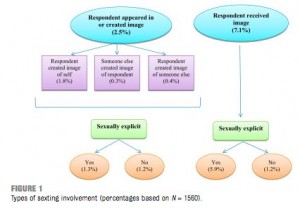Parents, you’ll probably appreciate knowing that young people are engaging in sexting a lot less than previously thought and that arrest is not typical in youth sexting cases. To help doctors and all the rest of us better understand the risks to youth of sexting, the authors of a national survey of US 10-to-17-year-olds just published in the medical journal Pediatrics aimed not only to get a better handle on the numbers but also to find out more about the kids who engage in it and the types of images involved, they say in the abstract of their article. They also wanted to look at how often teens are arrested for sexting, the characteristics of the cases law enforcement deals with, and the outcomes of such cases. The results of that investigation are published in a separate article in the same issue of Pediatrics.

99% of kids don’t create ‘sexts’
The very first survey on sexting by the National Campaign to Prevent Teen and Unplanned Pregnancy – one that’s still cited, unfortunately – put the figure at a scary 20% but unhelpfully threw both “sending” and “receiving” into the same survey question (see this 6/09 post) and was vague about the messages’ characteristics and even whether they were photos or texts. But in this latest study, by the Crimes Against Children Research Center at the University of New Hampshire, the authors found that “only about 1% of kids said they’d created or appeared in sexually explicit pictures,” said the youth study’s lead author Kimberly Mitchell in an audio interview for my ConnectSafely.org co-director Larry Magid in CNET. “Twenty-one percent of respondents appearing in or creating images reported feeling very or extremely upset, embarrassed, or afraid as a result, as did 25% of youth receiving images,” the authors wrote.
What kinds of photos are we talking about?
“Sexually explicit” means depiction of “breasts, genitals or a bottom,” Mitchell told Larry – imagery that could be classified as child pornography, which is the issue of greatest societal concern. The overall figure for “sexting” photos was 2.5%, but those included non-sexually explicit pictures (depictions of kids in underwear or bathing suits or even fully clothed in sexy poses). So only 1.3% could be considered classifiable as child pornography and illegal.
The authors found that about 7% of kids had received sexting photos. In her interview with Larry, Mitchell said the 7% could certainly be multiple copies of the same photo, not different photos of the same subject. “The study also found that older teens are much more likely to appear in such images than younger children. Just under three quarters (72% ) of the 2.5% who appeared in or created nude or nearly nude images were 16 or 17. Only 6% of that 2.5 percent were between 10 and 12,” Larry reported. All figures refer to “in the past year,” as in having sent or received over the last 12 months, not ever, Mitchell added.
Arrests mostly in cases of ‘aggravated’ sexting
CCRC researchers also surveyed law enforcement agencies, so we have unprecedented findings about the kinds of cases of “youth-producing sexual images” that involve arrests. They found that, in 2008 and 2009, “two-thirds of the [3,477] cases involved an ‘aggravating’ circumstance beyond the creation and/or dissemination of a sexual image.” Among those cases, “either an adult was involved (36% of those cases) or a minor engaged in malicious, non-consensual, or abusive behavior (31% of cases). An arrest occurred in 62% of cases with an adult involved, in 36% of the aggravated youth-only cases, and in 18% of the ‘experimental’ cases (youth-only and no aggravating elements).”
Those words “aggravated” and “experimental” are important. The CCRC published a typology of sexting cases earlier this year (see this), distinguishing between the two categories of sexting and helping law enforcement get a better a handle on the kinds of cases that merit legal intervention.
‘Experimental’ is not normative
“Experimental” sexting is far from normative because so rare but it does “appear to grow out of typical adolescent impulses to flirt, find romantic partners, experiment with sex, and get attention from peers.” It also doesn’t “involve adults or appear to include any intent to harm or reckless misuse,” the CCRC researchers write in Pediatrics. They conclude that most of the experimental sexting incidents that came to police attention “were more serious. Many involved criminal, malicious, or reckless behavior. Although cases with these elements are probably over-represented in police data and not frequent among the general population of adolescents, these are the most concerning cases and the situations that should be most targeted for intervention by clinicians.”
Two other findings about cases law enforcement did handle which might ease concerns a bit was that “most of the images (63%) were distributed by cell phone only and did not reach the Internet. Sex offender registration applied in only a few unusual cases.”
Correlated with other risk behaviors
In its coverage, the New York Times highlighted the important point that “31% [of kids] who appeared in or took sexual images said that alcohol or drug use had been a factor,” so there are correlations between sexting and other risk behaviors – which indicate situational or contextual as well as age factors involved in teen sexting. The Times pointed out similar findings by Pew/Internet this year, too. In a study I covered here, Pew found that 2% of 12-to-17-year-olds said they’d sent “nude or almost nude” pictures to someone they knew. But adults engage in sexting too – even more, hopefully not surprisingly. Pew found that “17% of adults between 18 and 29 had sent sexually suggestive pictures, and that 5 percent of 30-to-49-year-olds admitted sending them,” the Times reports. [Here’s the AP’s coverage.]

[…] “Sexting much rarer than thought to be” […]